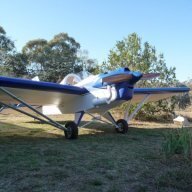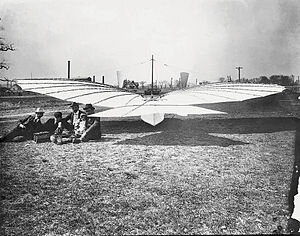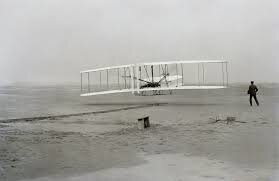-
Posts
560 -
Joined
-
Last visited
-
Days Won
8
Content Type
Profiles
Forums
Gallery
Downloads
Blogs
Events
Store
Aircraft
Resources
Tutorials
Articles
Classifieds
Movies
Books
Community Map
Quizzes
Videos Directory
Everything posted by Soleair
-
Plus most of the newer roads have constant radius bends, so you set your lean angle & go for it. I also found French car drivers to be very sympathetic to bikers, unlike just about every UK cage driver.
-
Here's a confession of the brash overconfidence of my youth. I had a small company intended to change the microlight world with a new plane of my own design. We built the prototype, and I had done the only flying on it, perhaps half a dozen hours. I decided it would be exciting for my two sons, then aged 6 & 4, to take them up one at a time for a short flight. A word on the structure. This was a rag & tube airframe, swept wing, canard. No enclosed seating area, as with trikes. The 'fuselage' was a pair of parallel tubes, with 1.25" o.d. tubing at each end, forming a rectangle. The seat was a simple hammock (made by my wife on her sewing machine) slung between the two ends. Because my children were so small, their little legs didn't reach the forward crossbar to rest upon. So I tied a piece of rope across the fore-&-aft tubes, and they rested their feet on that. No other structure between them and the ground 2500' below. The flight was uneventful, & I also took my wife up. She did not enjoy the experience, mainly, she claimed, because she kept thinking that her stitching on the hammock seat was all that stood between her and certain death on the unforgiving ground so far below. So in summary I risked the lives of my family on a brand new, unproven design, built from commercial material no airworthy standards, that had undergone no inspection other than my own, using a single ignition 2 stroke with my own reduction drive system. All this was completely legal at the time (1982 in UK), but I still cringe when I consider with the painfully acquired wisdom of my autumn years the foolhardiness of such a decision. Fortunately, my boys were unscarred mentally, & both went on to solo gliders whilst in their teens. My wife has never flown in anything smaller than a 727 since. Bruce
-
https://www.manchestereveningnews.co.uk/news/greater-manchester-news/robert-murgatroyd-pilot-barton-crash-15860828
-
I passed my bike test in 1967 & have owned a bike most of my adult life. When I lived in England I went for my Advanced Motorcyclists ticket. This entailed approx 18 months of Saturdays, mostly riding one-on-one with police class 1 motorcycle mentors. I was taught that the purpose of the advanced motorcycling course was to 'make progress safely'. As part of this, I was taught to filter between lanes of slow moving or stationary traffic. I doubt these experienced bikers would appreciate themselves or their students being called "smart-arses" because they were exploiting the capabilities of their bikes. Car drivers have the benefit of a roof over their head to keep dry, aircon in summer to keep cool, and a heater in winter to stay warm. Bikes don't have these advantages, but they are more manoeuvrable and require less road space. I don't object to car drivers' comfort, and it is not reasonable for them to object to my ability to make progress just because they can't. Bruce
-

New Electric Ultralight/Light Sport
Soleair replied to Oshkosh Demos's topic in AUS/NZ General Discussion
Especially if the little wheel was in the right place. -
I was taught to adjust speed with elevator and rate of descent with throttle. Bruce
-
https://www.bbc.co.uk/news/uk-england-sussex-46623754 Cut off their goolies.
-

A Beaut Little Ultralight! Merry Christmas Everyone!
Soleair replied to farri's topic in AUS/NZ General Discussion
OK, I'll bite. Merry Chriistmas! Bruce -
I worked for several years as a radio operator in a Fire Control Centre for NSW Rural Fire Service. We were the conduit for all radiotelephony between FCC & the fireground. Since all rural fireys are volunteers, with varying experience, standards of radio calls differed greatly. The old Standard Operating Procedure for radio terminology called for "affirmative". I have personal experience of the difficulties this causes, when the operator is not speaking clearly (raging bushfire outside the cab), when terrain degrades the signal, and when the first couple of seconds is not transmitted after the ptt button is pressed due to the system itself. Even asking for a repeat still often results in multiple "##@%&*<%#..ative" Only the last syllables come through. It is clearly unwise to use two words sharing much of their sound when their meanings are opposites. So eventually the SOP's were changed and "Affirm" became the required word, with the emphasis on the first syllable. This mostly worked, except for a few older hands. These guys complained that they'd been trained to use affirmative, they'd always used it, & didn't see the point of changing. Had they heard what we heard, with scratchy radio transmissions sometimes conveying urgent and important information, they may have appreciated the need for change. Bruce
-

Were the Wright Brothers in Newton's camp?
Soleair replied to old man emu's topic in Aircraft General Discussion
There are several witnesses who claim to have seen Whitehead fly. None other than 'Jane's All the World's Aircraft' credits him as the first to build & fly an operational heavier-than-air flying machine. The Wrights were not just great designers & builders. They also showed considerable business & self-publicising acumen, unfortunately coupled with a (not so great) dollop of greed, which ultimately held back aviation development. Just because Whitehead did not go on to run a successful aircraft company (or even manage his publicity at all well), doesn't mean he wasn't the first. As I know from personal experience, the skills required to design, build & fly an aircraft are very different from those required to run a business. The photo shows what to me looks a viable airframe: note in particular the dihedral, as opposed to the anhedral in the Wright flyer. A couple of replica Whitehead 21 replicas have been built & flown successfully. Bruce -

Were the Wright Brothers in Newton's camp?
Soleair replied to old man emu's topic in Aircraft General Discussion
Why this constant endorsement of the Wright bros claim to be first to fly a powered aircraft? It was Gustave Whitehead (nee Weisskopf) who was first, predating the Wrights by 2 years. "History is the propaganda of the victors" Bruce -
That brought back memories, Phil. In 1979, I imported a Pterodactyl kit from the States, & built it in my shed. No microlight schools on the Isle of Wight in those days, so I taught myself to fly it from nearby farmers' fields (which were way too small). Eventually got to fly it ok, so went cross country. I took off an hour or so before dawn from my home paddock on the Island, as I wanted to try night flying. I flew to a mate's house on the Isle of Sheppey. Somewhere north of Brighton, I needed to refuel. I found a little village with a recreation ground on top of a little hill, and opposite it was a petrol station. I landed on the footy field, and unstrapped the fuel tank. Carried it over the road and filled it with mogas from the pump, plus my stash of 2-stroke oil. By the time I got back to my plane, half the village had turned out. It was a very noisy direct drive system, and microlights were all but unknown in those days, so they'd all turned out to see this strange flying machine. One guy struggled to believe I'd come from the IOW that morning. I took off between the 2 sets of goal posts, & managed a double arm wave to the masses as I headed north east, into the increasingly murky weather of a front, as it happened. Made it to the Isle of Sheppey, but after my arrival sad to say my 'Dactyl was in more than one piece. But that's another story. . . Quite a few of my contemporaries landed by motorway fuel stations to refuel. And I once landed in a field by a pub just down the road from Popham Airfield to ask the way. Everything seemed so much simpler in those days: no licence needed; no inspection or build regs; and initially, the only instrument I carried was a Ventimeter for an ASI. Aye, but it were fun! Bruce
-

Trailers for Trikes
Soleair replied to cscotthendry's topic in Trikes and Microlight Aircraft Usergroup
Looking through this thread I was very surprised that nobody has mentioned suspension (unless I've missed a posting). I would have included appropriate suspension right up there in the initial 'wish list' in post #1. The problem with just buying standard self-build trailer components is that in general they are designed for carrying maximum rather than minimum weights - typically 500 or 750 kg box trailers being the norm. But few trikes are going to weigh this much, even with spare wheels, tools, fuel, etc. Maybe half that weight. So with these 'off the shelf' suspension setups, the spring rate will be very stiff. This will transmit harsh vertical accelerations into the trike, which can easily damage the structure over time, and very quickly bugger the sensitive flight instruments like altimeter, ASI, etc. If you are building a purpose built trailer from the ground up, I would suggest you design long travel, soft suspension. This is almost the exact opposite to the half elliptic carthorse spring setup on all the pics I've seen on this thread. You should also not aim to make the trailer itself too light. A very light trailer will skitter about over bumps, as it does not have the inertia to allow the platform to tend to remain steady & the wheels to move up & down. When I towed my MiniMax from NSW to Victoria, I ballasted my small converted box trailer with steel section to bring it up to maximum placarded weight for this reason. Ideally you'd use long coil springs, but failing that, remove one or more leaves off the half elliptic springs to reduce the spring rate. If you have the option, the best wheels are the largest diameter you can fit, with fat tyres run at minimum pressure, again to provide energy absorption. So in summary: long travel, soft suspension; large diameter soft tyres; ballasted trailer. Particularly if you plan on off roading or come across the dreaded corrugations found in more remote areas. Bruce -
I agree: few pilots seem to use this useful manoeuvre regularly, if at all. My MiniMax slips very effectively, with large area control surfaces & low momentum. So a sideslip (or more accurately, a forward slip since it is along the direction of original travel), is my preferred method of losing excess height on late final. Yet on videos posted of MiniMax flights, I've never seen this - it's always a series of S turns at increasingly low level. Which strikes me as much more potentially dangerous. And the instructor who I flew with to get my hours for converting my UK licence to Australian was alarmed when I banked more than 10º to start a slip. Why? It's a very controllable regime, provided you keep speed up, with adequate margin for position error on the pitot. Bruce
-
I love it! Super flying position, too. i want one. . . Bruce
-

Were the Wright Brothers in Newton's camp?
Soleair replied to old man emu's topic in Aircraft General Discussion
I think the book FH refers to in post #34 may be A.C.Kermode's excellent "Flight without Formulae". I lent mine many years ago & never got it back, but as I recall it did an excellent job of explaining the principles of flight without complex mathematics. Bruce -
Or, for dabblers in the metaphysical: "This door is alarmed"
-
I needed access to some internal fixings on my MiniMax, & had to cut a 4" circular access hole through the 1.8oz dacron to do so. I won't need to get to these again, so need to re-cover the hole. I have spare fabric, but no glue. The surface I need to bond to is cured 'latex' (acrylic) paint. Can anyone suggest what type of adhesive i could use to bond a circular patch over the access hole? It's on the underside of the rear fuselage, so not in critical airflow area. And I don't want to buy a big tin of Polyfiber glue, due to high cost of shipping. Thanks in advance Bruce
-
Quite a well known MiniMax. At least in UK/MiniMax circles! Shame it's not registered in Germany. Then it could be D-GSBOLLX. Hmmm- perhaps not. . . Bruce
-
To answer your original question, until recently I flew regularly from Mudgee airport in NSW. There is a twice daily RPT operating from there to Sydney, and Mudgee Aero Club members fly mainly ultralights. My own aircraft is a 95.10 MiniMax, & I have made radio contact with RPT pilot a couple of times ensuring separation, etc, with no problems. I hope this helps in your mission against the little man with a big hat. Bruce
-
Hi Billi & welcome. Homebuilding is a lot of fun, & very satisfying. I built my current aeroplane. Here is a link to the company that supplies drawings (or a kit, if you wish): Experimental Aircraft Certification Kit My eros has an empty weight of 193 kg. If that is too heavy to consider powering with an electric motor, have a look at Mike Sandlin's GOAT. Goat Page Free drawings online, suits lightweight pilot & could be modified for electric power, assuming you have sufficient technical knowledge or support. Enjoy your journey! Bruce
-
The third pic I can only assume is the face of God, as touched by those who dance on laughter-silvered wings (sorry Mr Magee. . .)
-
The second picture is of 'mammatus' or 'mammatocumulus' clouds. These usually hang from cumulonimbus clouds, as seen in the pic you show. And yes, they are named from the Latin after their similarity to a pendulous breast :) Bruce
-

DooMaw - building a STOL
Soleair replied to Head in the clouds's topic in Aircraft Building and Design Discussion
Congrats on both your new plane & your certified status. I'm sure you'll have so much fun now you'll have to discipline build time back in to your day! Bruce








